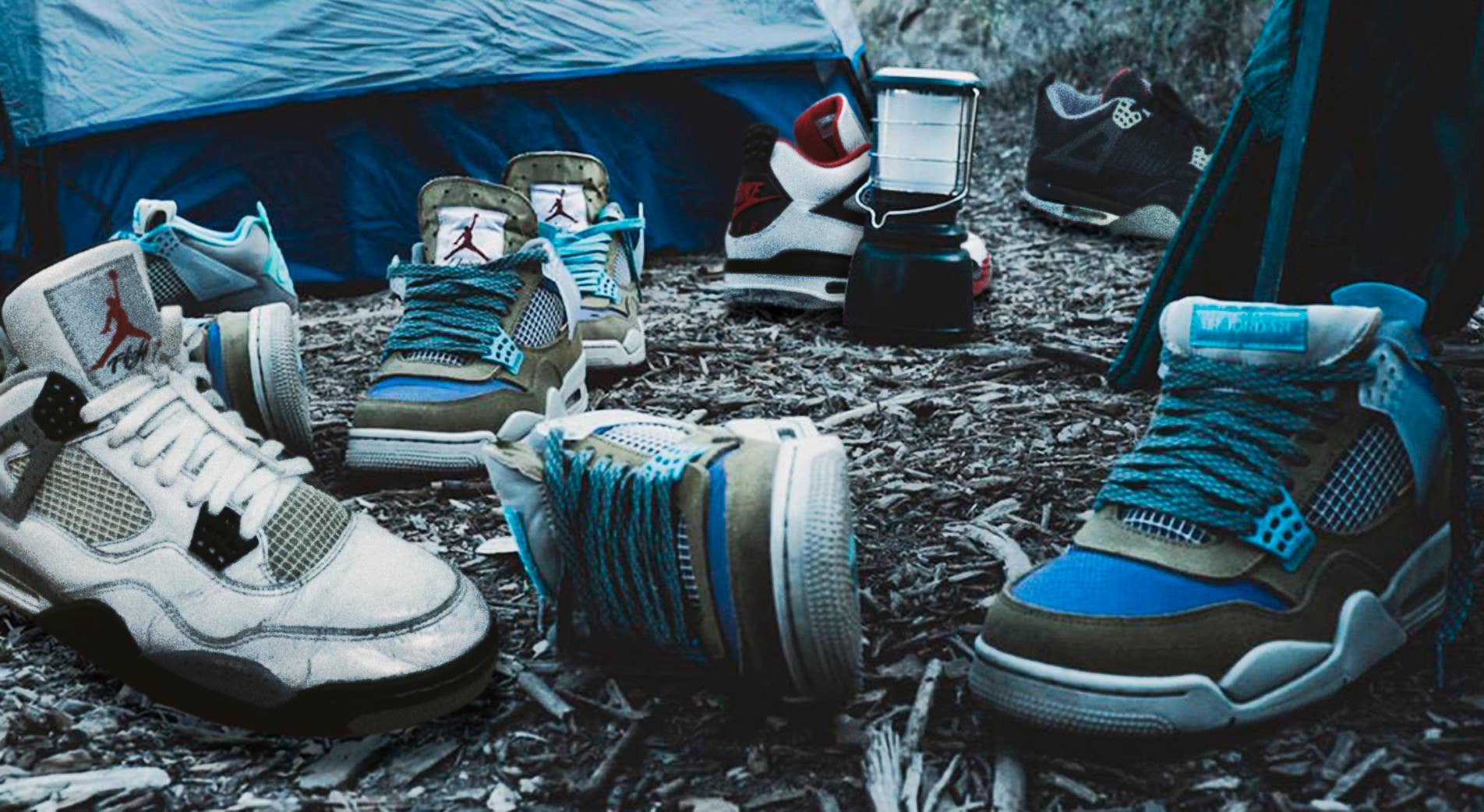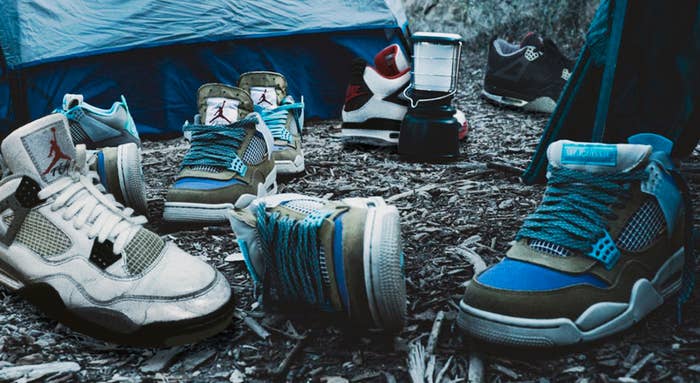
Getting outside has never been cooler. Outdoor gear has been a staple of street style for decades, but it didn’t permeate quite like it does these days. We’re in a time when The North Face covers its Nuptse puffer in Gucci’s monogram motif, Arc’teryx collaborates with buzzy UK skate brand Palace, and Michael Jordan’s fourth signature sneaker gets doused in hiking-friendly hues and materials courtesy of streetwear pioneer Union.
Some call the movement Gorpcore, a portmanteau of Gorp, hiker lingo for “good ol’ raisins and peanuts,” and normcore, said to be coined by The Cut in 2017. Think Patagonia deep-pile fleeces paired with designer sneakers, Salomons in the streets, and Arc’teryx shells despite zero chance of precipitation. For another subset of people, it’s more than an op-ed on the latest Lower East Side trend. As banal as it may sound, for some, it’s a lifestyle. Whether it’s full-on utilitarian usage in the mountains or functionality with a touch of flexing in the city, the desire for outdoor gear has always been there, and now it’s amplified.
From around the early 1990s to today, what started as a practical—and stylish to boot—tool for day-to-day city life became connoisseur’s garb before going full-on Wall Street Journal. Yet despite its mainstream spread, is it fair to even consider the outdoor enthusiasm a trend? In order to really explore the topic, we must look at where it started, where it’s been, and where it is today.
The roots of the outdoor trend in street fashion can be traced back to the late ‘80s and early ‘90s. As is often the case with style, areas like New York City were ahead of the curve during this period, helping lay the foundation for the performance-outerwear-turned-lifestyle-necessity movement. In NYC, shops like Tent & Trails and Paragon Sports helped introduce gear that was built for mountain excursions, but ended up getting co-opted by hip-hop fans and graffiti writers looking for apparel that would double as protection from the elements and storage for everyday essentials.
“Obviously it’s cold in the winter and someone had to wear something that’s warm,” says Paul Mittleman, a creative director who currently works with Adidas and is known for his formative work with brands like Stüssy in the ‘90s. “People started seeing that you could wear a down jacket that was obviously made for outdoor, but appropriated for the city. People started going into Paragon and Tent & Trails to buy outdoor clothing. Again, it was for warmth. I think the outdoor stuff was, in the beginning, a bit more practical, then it got collectively taken as a look.”
Along with the interest in brands like Arc’teryx and The North Face as well as workwear-oriented labels like Carhartt and Timberland, Mittleman credits brands like Polo Ralph Lauren, Nautica, and Tommy Hilfiger for embracing the outdoors early on and incorporating these designs into their menswear lines. One of the more iconic pieces to emerge from this co-opting was Polo’s outdoors-themed Sportsman line and the Polo Snow Beach pullover, famously worn by Wu-Tang Clan’s Raekwon in the group’s “Can It All Be So Simple” music video.
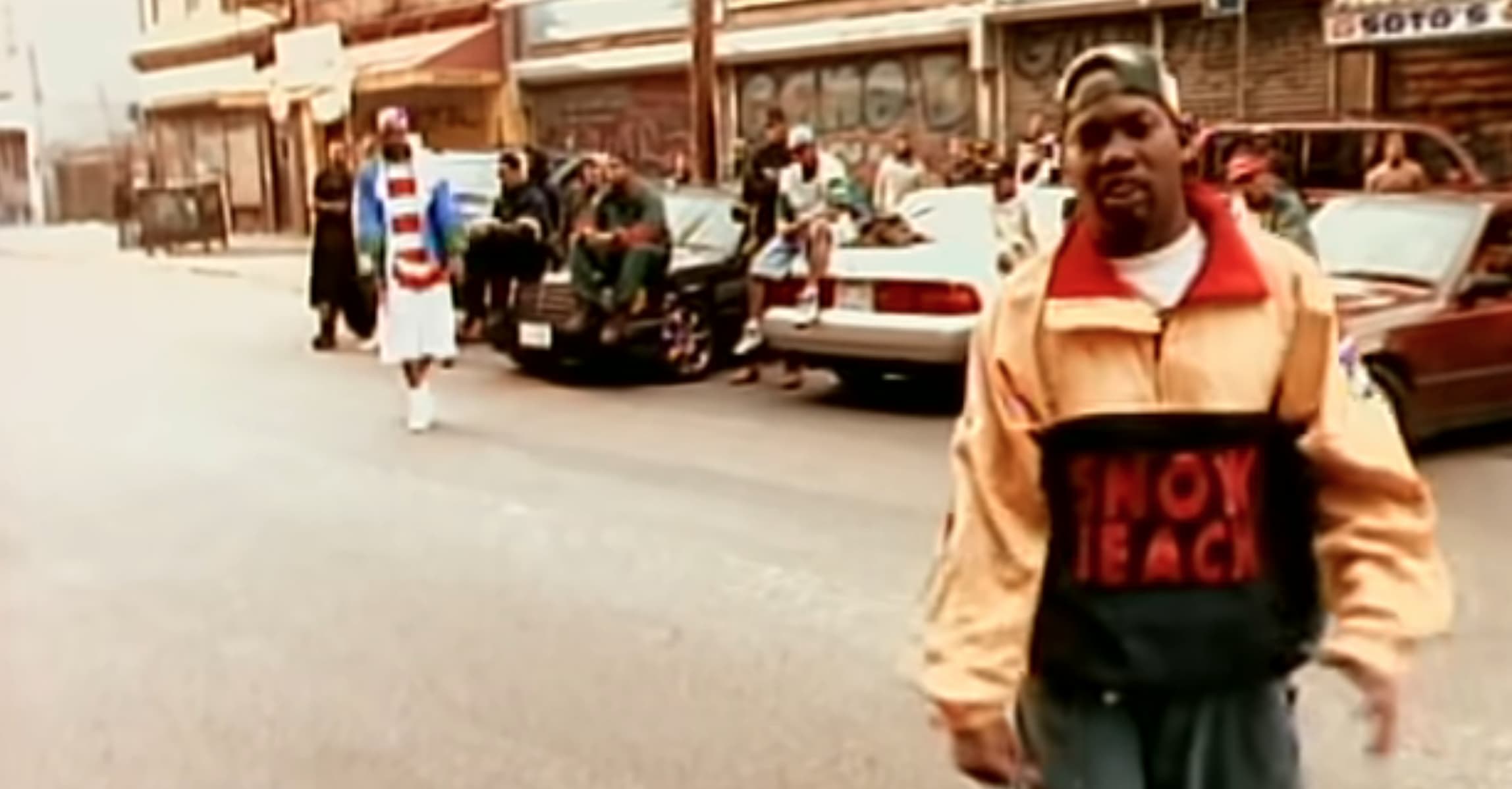
Leo Gamboa, a senior product marketing manager specializing in collaborations at Reebok, witnessed the evolution of the trend firsthand growing up in New York at the time.
“I’d say that outerwear, that The North Face, that Marmot, that Arc’teryx type of vibe, definitely started in New York City,” Gamboa says. “I think that New York is a big part of it and we definitely grew into it. Coming from wearing Ralph Lauren and then intertwining it with outerwear. The uniform at that time was a [The North Face] Mountain Jacket with a Polo sweater under it. It was just what you would wear and then with jeans and a pair of [Vasque] Skywalk boots, that seemed to be a good uniform back in the day when I was in high school. I definitely think that New York was the leader in the sense of this outerwear trend.”
The owner of Union Los Angeles, which released its “Tent & Trail” Air Jordan 4 collaboration in June, had an introduction to outerwear that was more along the lines of what designers had originally intended. Chris Gibbs was raised in Ottawa, Canada, where extreme temperatures were an everyday thing, and he participated in activities like skiing, camping, and hiking. When he and his family arrived in New York in 1996, the Union owner was taken aback to see the clothing he wore in Canada repurposed as street gear.
“That was what everybody wore in Canada,” Gibbs says. “So when I got to New York and the streets were wearing North Face and Patagonia and juxtaposing it in a very different way, at first, it wasn’t something that I embraced. I was like, ‘No, I wore all those brands like normal.’ And so it took me a little while to come around, but over time, I came to understand and appreciate the actual juxtaposition of like, ‘Oh, these are these traditional hiking and outdoor gear made for those purposes, but the streets, the youth, they’re taking it and using it and styling it in a completely different way.’”
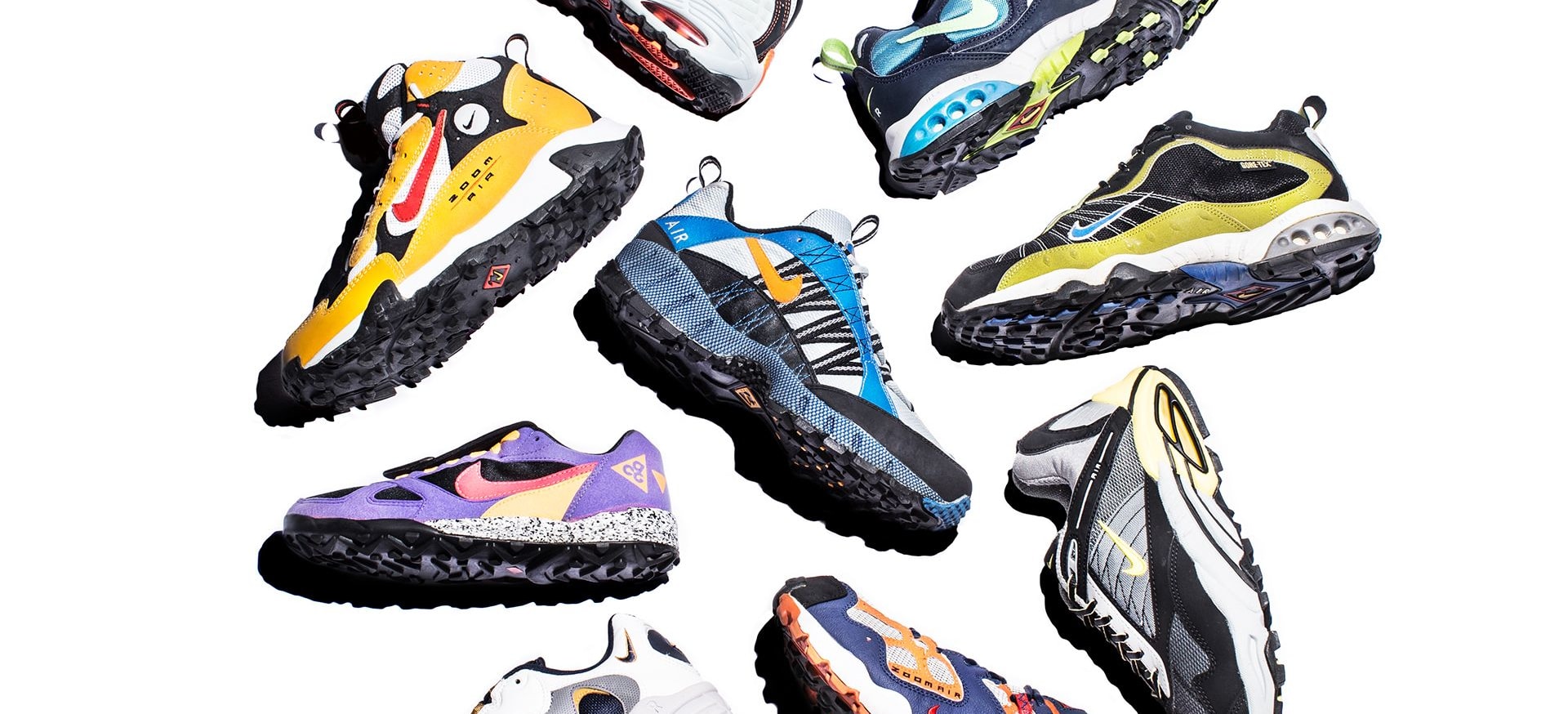
In terms of footwear, boots from brands like the aforementioned Timberland and Vasque dominated the look in the early ‘90s. Soon, a Nike offshoot that launched in the late ‘80s would join the rotation. ACG, short for All Conditions Gear, was an update on the brand’s short-lived Nike Hiking line and introduced colorful, trail-ready sneakers such as the Air Mowabb (1991), Air Baltoro (1990), and the Wildwood (1990).
ACG was preceded by Nike Hiking, which launched in 1981 and included models like the Approach, Lava Dome, and Magma. The line was said to be inspired by a famous photo of mountaineers Rick Ridgeway (current VP of environmental initiatives and special media projects at Patagonia) and John Roskelley from 1978. The two climbers had just finished the seemingly insurmountable task of summiting the K2 mountain, making their group the first Americans to do so. On their feet were tattered and torn pairs of Nike LDVs in yellow, which not only spurred the idea of Nike Hiking, but served as built-in marketing. “Not everyone was willing to wait for our hiking boots,” the advertisement read.
In 1989, Nike Hiking became ACG as Swoosh doubled down on the outdoor inspiration. Designers like Steve McDonald, Peter Fogg, and Sergio Lozano helped shape the direction of the line in its formative years. The design language of one ACG model in particular, 1991’s Air Terra ACG, would later trickle into noteworthy Nike models like the Air Humara and Air Terra Humara.
“In that time, ACG was really strong. Like really, really strong,” Gibbs says. “Especially in New York, the whole city. At that time, ACG would have been probably the No. 1 worn sneaker brand. Like the Humaras and the likes of those shoes were extremely popular [in the] late ‘90s.”
Throughout the mid-to-late ‘90s and the new millennium, another fashion-forward metropolis would put its spin on the trend. In Tokyo, Japanese designers like Nigo (A Bathing Ape), Hiroshi Fujiwara (Fragment Design), and Hiroki Nakamura (Visvim) took what NYC had started and filtered it through their respective lenses.
“I think Japan always does a great thing of refining Americana then taking it to their own thing and then starting their own brands, like a Visvim, which was influenced by snowboarding, menswear, streetwear Americana,” says Mittleman.
On a March 2021 episode of The Complex Sneakers Podcast, Mittleman recounted one of Fujiwara and Nakamura’s early visits to New York. Arc’teryx, which was founded in 1989, had just begun popping up at stores in the city at places like Paragon Sports, and Mittleman was wearing one of the brand’s jackets when he met up with the duo. After they expressed interest in the jacket, he took them on a shopping trip to Paragon.
“Everyone was like, ‘Wow, these are insane: articulated seams, seam-sealed,’” Mittleman said. “I think they each bought one or two, and I maybe bought another one. And then that trip, in a way, starts to inform their obsession with outdoor, and especially where Hiroki starts taking Visvim because they were all starting to talk about that idea… That language really has stuck, of completely high-end, technical outdoor wear, that I think it’s the most popular thing in the world right now. Everyone loves outdoor.”

With inspiration from brands like Arc’teryx, The North Face, and Patagonia and previously untapped materials like Gore-Tex in tow, Japanese designers helped further the appeal of the outdoors in the streets.
Prior to starting Visvim in 2000, Nakamura refined his eye for outerwear during a stint at Burton Snowboards, a company that has also worked with Fujiwara and Acronym founder Errolson Hugh.
“If you think of early Visvim apparel, the linchpin of the success was [Nakamura’s] embrace and really his take on how to use Gore-Tex,” Gibbs says. “Visvim today still has that as part of an element of the brand, but the foundation of the apparel really centered around his very genius and unique take on how to work with Gore-Tex. And that had a lot to do with his background at Burton and therefore access to Gore-Tex through that.”
While Visvim leaned into Americana heritage-based design language, Nigo’s Bape was outfitting the material with more of a hip-hop-inspired streetwear edge. His vision of Gore-Tex included the brand’s signature camouflage pattern and shark graphics. Japanese designers had a key advantage over those from other areas that allowed them more room to experiment: access.
“Gore-Tex Japan had much easier testing approval,” Mittleman says. “Gore-Tex America or Europe has much stricter testing. Local Japanese companies were able to make more lifestyle Gore-Tex with a different testing scale, which you couldn’t really pull off here. Now you’re seeing it more because I know Gore-Tex wants to get a bit more involved in ‘lifestyle clothing and lifestyle footwear’ because they kind of own technical. Japan had their own spin on it.”
Gibbs echoes the differences between Gore-Tex in Japan and America, noting that early on, US brands were usually only able to use the material in black. Meanwhile, Nakamura, Nigo, and other Japanese designers took advantage of their regional license which was more lax and required fewer minimum units for production.

While Japan was busy perfecting its version of outerwear throughout the 2000s, the trend took a backseat in the States.
“In the early aughts, it started to become pop,” Gibbs says. “And when it first popped, like your federated stores, like the Macy’s of the world and all the stores on Broadway, were like, ‘Oh, shit. This streetwear thing, it’s a new thing. Let’s get onto it.’ And they hopped onto the business model part of it, but they never understood the culture. For better or for worse, it didn’t last. I think because there was no real foundation, there was no connection to the foundation of the culture part of it.”
By the time The Cut made Gorpcore a thing in 2017, the trend already had gotten back some of its momentum in popular style. Streetwear brands like Supreme and Fuct were adding imitations of Patagonia’s Retro-X and Snap-T fleeces to their fall collections. Wet weather jackets were equally in vogue, whether it be one of Acronym’s no-detail-spared designs or Gucci’s Spring/Summer 2014 reinterpretation of said jackets. But the outdoor inspiration still had room to grow in the sneaker and streetwear space.
From Nike’s ACG line to rugged boots from the likes of Merrell and Vasque, footwear has always been a core piece of the outdoor repertoire. Yet despite the cult-like following around ACG and a handful of collaborative projects throughout the 2010s like Acronym x Nike and White Mountaineering x Adidas, the two worlds were never as interconnected as they are today.
The partnership between Jordan Brand and Gibbs’ Union began with 2018’s Air Jordan 1 and continued this year with two Air Jordan 4 releases in celebration of the store’s 30th anniversary. Both pairs used the same remixed upper seen on Union’s 2019 Air Jordan 4 releases but featured a much different color theme. The sporty vintage shades of the prior drop were replaced with dusty taupes and golds, accented with pops of pastel purple and teal. With the arrival of the collection’s lookbook, which featured the shoes styled with camping gear through washed-out filters, it was clear where the inspiration came from.
“I was like, ‘Yo, it’d be really fun to see these and treat them through the lens of a hiking boot,’” Gibbs says. “Whenever I’m presented with a new challenge, from a design point of view, I just start thinking about how I would want to see them, how I would want to wear them. It’s very personal. It’s very organic. It’s not like, ‘Oh, what new, different thing can I do?’ And for some reason, I just thought that the actual design, original design, of the 4 lent itself really well to reimagining it as a hiking boot.”
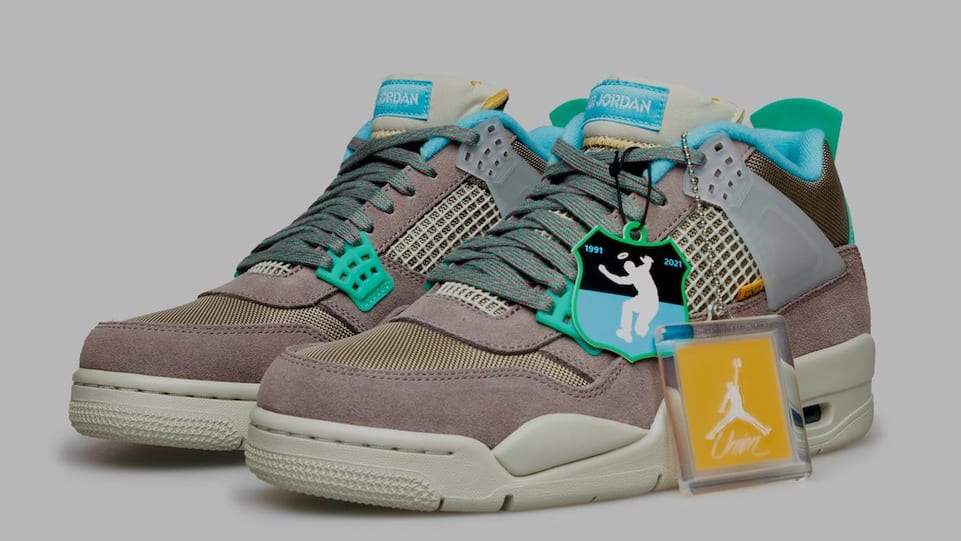
Gibbs’ childhood inspiration ended up making for one of the best sneakers of the year. The Union-exclusive Taupe Haze colorway regularly resells for over $600, making it one of the most expensive, too.
Recently, outdoor themes and hiking-informed color palettes have been finding their way onto popular sneakers more than ever. Former Versace and Yeezy designer Salehe Bembury has released a number of such pairs with New Balance on the 2002R model as well as a project with Chinese brand Anta. Round Two co-founder Sean Wotherspoon just released his Adidas Superturf Adventure sneakers complete with an outdoor-focused campaign. New Balance’s Snow Peak collaborations went full technical, offering a 3-in-1 construction that can be worn as a waterproof boot, a sneaker, or a mule. Salomon has collaborated with the likes of @organiclab.zip, an outdoor-centric Instagram mood board. And Gamboa’s work at Reebok has included a revitalization of the trail-friendly Beatnik sandal from 1994.
Others in the space are taking a more abstract approach. Nicole McLaughlin is a consultant who previously worked at Reebok and is currently the first-ever design ambassador for Arc’teryx. She represents a younger generation and the ways they’re shaping outdoor gear for their world. Her DIY designs, which repurpose used materials such as apparel and clothing, encompass everything from hacked-up Whole Foods bags to fanny packs given new lives as sandals. Chances are, you’ve seen at least a few of them on your Instagram Explore page if you’re not already following her. And while many of McLaughlin’s designs feel pre-programmed for virality, pushing the ridiculousness envelope a little further each time, she makes it a point to keep practical use in mind—while attempting to shake things up a bit.
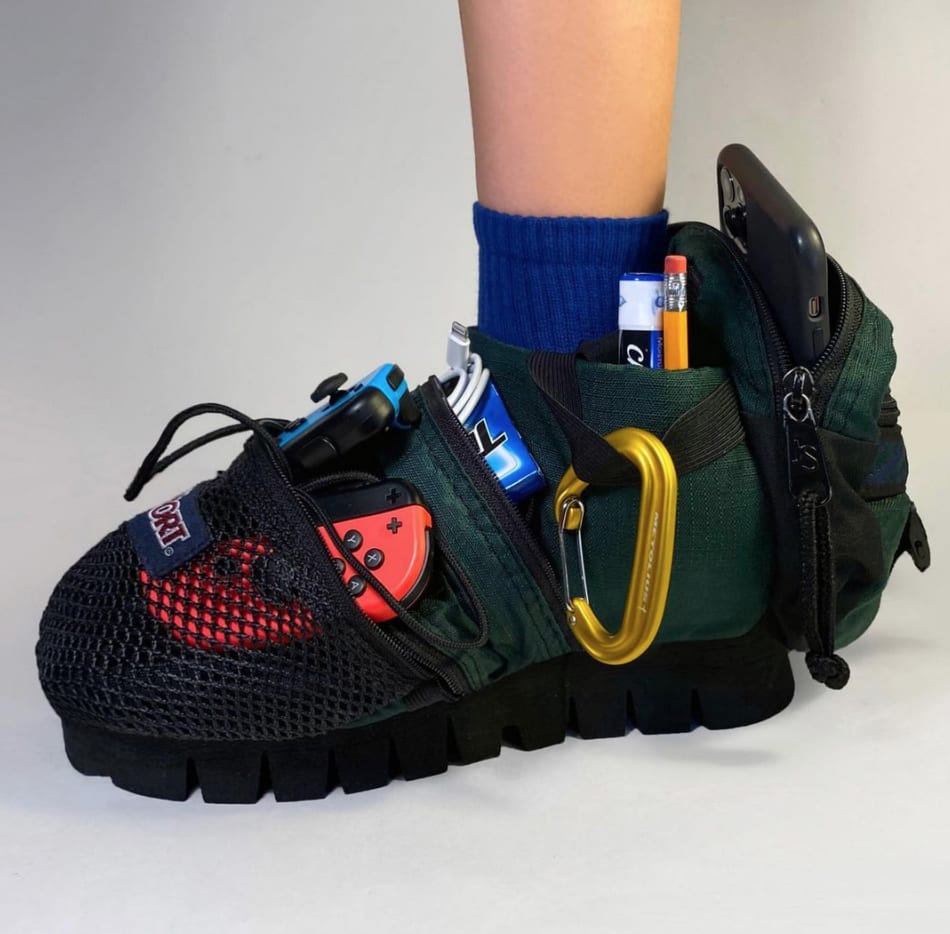
“I love functionality, and sometimes I take it almost too far and make it kind of like a funny type thing,” McLaughlin says. “But a lot of the stuff that I make is really considered in how I place things, and [uses] elements that I don’t see enough of out there in the world.”
McLaughlin says growing up, outdoor gear for her served more of a utilitarian purpose rather than as a fashion statement, a mindset she sticks with today. “Personally, I love the functional materials, the reflective details, like when it has Gore-Tex, things that are actually going to protect you if you were in a situation that you would need them to,” she says.
The different philosophies around outdoor gear also apply to its legs as a trend. Does it risk oversaturation and getting played out now that it’s inspiring some of the year’s biggest sneakers, or is there more ground to cover? Is it even fair to call it a trend, or is it becoming something even more grandiose?
“Outdoor fashion, it’s just always been the coolest thing to me,” Gamboa says. “In my opinion, this is not a trend, it’s just always been cool. It’s something that I would live and breathe forever. Right now, it is as popular as it is and it’s just bringing more visibility onto it, but it doesn’t really affect my take on it. I hope the current market and how crazy commercialized it’s become doesn’t affect people’s mindset towards it. Because people are still going to be wearing this, no matter what, when the trend dies. You’re always going to need a Gore-Tex jacket. You’re always going to need a fleece. You’re always going to need footwear that’s inspired by some type of trail. It’s just a forever thing.”
Mittleman shares a similar take on the future of outdoor gear and its influence on footwear.
“I don’t think this is a trend anymore, I think this is a lifestyle choice,” he says. “I don’t think people going outside to do activities is going to go away. For social reasons, for health reasons. Why not bring a picnic to the park or make a day drive up to a mountain and hike a little bit, or go mountain biking, kayaking, paddle boarding or surfing or whatever you want to do?”
Gibbs, who crafted what’s arguably peak of outdoor-inspired sneakers thus far with Union’s Air Jordan 4, looks to the locale that perfected outdoor gear in the 2000s for a hint of what’s to come next.
“I go to Japan to see where it’s going,” he says. “Wherever we’re at in streetwear globally, Japan’s been there for five-plus years. So, is streetwear dead in Japan? No, it’s not. It’s thriving… That’s what I believe is coming for America.”

